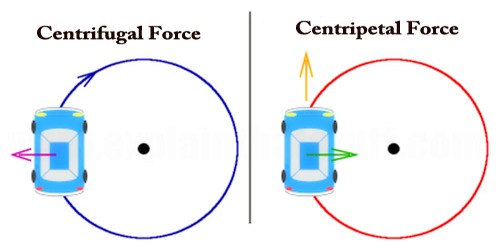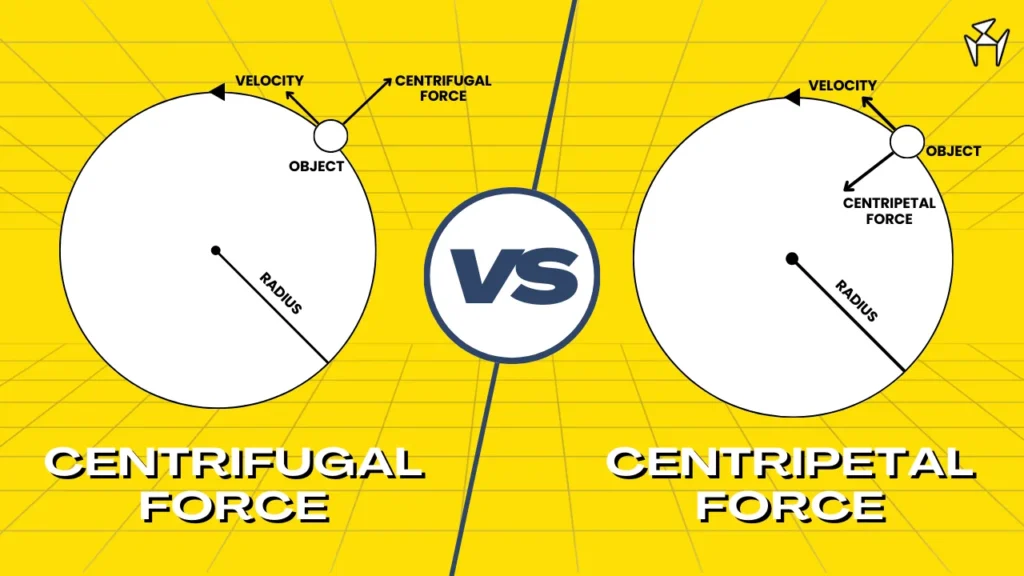Centripetal force pulls things toward the center when they’re moving in a circle, like when you swing a yo-yo around. It keeps them from flying off in a straight line. Centrifugal force feels like things are being pushed outward when they’re spinning around.
However, it’s merely how things appear due to inertia, much as when you’re riding a spinning teacup ride at the fair; it’s not a real force. When it comes to interpersonal relationships, centripetal forces unite individuals via commonalities like friendship or ideals.
But centrifugal forces push them apart, like when there are big differences in culture or language. Understanding these ideas helps us understand how things move in circles and how people get along—or don’t—in groups.
How does centripetal force maintain circular motion?

Centripetal force is the force that keeps an object moving in a circular path. It acts towards the center of the circle and is responsible for constantly changing the direction of the object’s velocity, thereby keeping it in circular motion.
The key principle at play is Newton’s first law of motion, which states that an object in motion will continue in a straight line at a constant speed unless acted upon by an external force. In circular motion, the object’s inertia (its tendency to continue moving in a straight line) would cause it to fly off in a straight line if there were no force acting on it. However, the centripetal force continuously pulls the object towards the center of the circle, preventing it from flying off tangentially.
Centripetal force can be provided by various sources depending on the context. For example, when you swing a ball attached to a string around in a circle, tension in the string provides the centripetal force. In the case of an orbiting satellite, gravity acts as the centripetal force. In a car making a turn, friction between the tires and the road provides the necessary centripetal force.
What causes the perception of centrifugal force?
The perception of centrifugal force is actually a result of inertia. When an object is moving in a circular path, it tends to move in a straight line due to its inertia. However, a centripetal force (inward force) is acting on the object, keeping it in the circular path.
From the perspective of an observer in a rotating reference frame (for example, someone standing on a spinning platform or in a turning car), they experience a sensation of being pushed outward. This sensation is perceived as a centrifugal force, but it’s not a true force like centripetal force. Instead, it’s a result of inertia trying to keep the observer moving in a straight line while they are actually moving in a curved path due to the centripetal force.
So, the perception of centrifugal force is not caused by an actual outward force acting on the observer, but rather by the observer’s inertia resisting the change in direction caused by the centripetal force. It’s important to note that centrifugal force is a fictitious or apparent force, meaning it only appears to exist from the perspective of a rotating reference frame and is not a real force in the traditional sense like gravity or electromagnetism.
What are centripetal and centrifugal forces in social sciences?

In social sciences, centripetal and centrifugal forces are concepts used to describe factors that either unify or divide societies, cultures, or groups.
Centripetal forces
These are factors that promote unity, cohesion, and stability within a society or group. Centripetal forces can include shared cultural values, common language, strong leadership, economic prosperity, inclusive policies, and effective institutions. These forces tend to bring people together and strengthen social bonds.
Centrifugal forces
On the other hand, centrifugal forces are factors that contribute to division, disunity, or instability within a society or group. These forces can include ethnic or religious tensions, economic inequality, political instability, linguistic diversity, regional disparities, discrimination, and social exclusion. Centrifugal forces often create divisions or tensions that pull people or groups apart.
In social sciences, the interplay between centripetal and centrifugal forces helps explain the dynamics of social cohesion, identity formation, conflict, and cooperation within societies or among different social groups.
Understanding these forces is crucial for policymakers, sociologists, anthropologists, and other scholars studying social dynamics and attempting to promote stability, inclusivity, and social harmony.
Final Words
So, to wrap it up, we talked about two kinds of forces: centripetal and centrifugal. Centripetal force pulls stuff toward the center when they go in circles, like when you spin a toy around. Centrifugal force feels like things are getting pushed away when they spin, but it’s just how it seems because of how things move. .
We also talked about how these forces work with people: some bring them together, like when they share stuff or are friends, and some push them apart, like when they’re different in culture or language. Understanding this stuff helps us see how things move and how people get along in groups.
